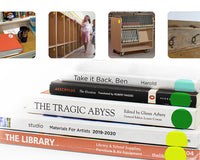If you work with books or office supplies, you’ve probably seen the term “acid-free” at one point or another. Ever wonder what that means? Well, since acid makes things break down over time, acid-free materials are longer-lasting and even suitable for preservation. Discover the importance of using acid-free materials in books.
What’s Up with Acidity?
Acidity and alkalinity are how scientists describe different kinds of molecules and their reactivity. Acids tend to be corrosive and sour, and they turn litmus paper red. Bases, on the other hand, are slippery and bitter and turn litmus paper blue. Everything from food and plastic to the human body contains acids and bases.
Acid-Free Paper
You’re probably aware that paper today comes from trees, but did you know that this wasn’t always the case? Western civilization first made paper using rags, mostly from natural-fiber cloths like linen and cotton. In the 16th and 17th centuries, poor women and girls were often in charge of collecting these rags from garbage piles or going door-to-door. Then, the paper manufacturers would break down the rags in large tubs of urine (we know—it’s super gross).
After they had created a pulp from the cloth, the manufacturers would make sheets of paper, squeeze all the water out, and hang them to dry. By the end of the process, the fibers in the paper were still fairly long. Scientists today know that the long fibers are why 500-year-old paper holds up so well.
Unfortunately, in the 19th century, we started making paper from wood pulp and began integrating mechanical processes. All of this contributed to shorter fibers in paper, which increased its acidity. If you compare a book from the 1800s to one made in the 1600s, there’s a good chance the older book’s paper will be in better shape!
To get around this problem, modern paper manufacturers have started adding alkaline buffers to retard the acidic breakdown of paper. If you have important documents that need to last longer than a few decades, your best bet is to look for paper that meets the ANSI/NISO paper permanence standards.
Archival Ink
Whenever you see a pen with an “archival ink” label, the ink should last a long time without fading, and it should be nigh impossible to wash off. You don’t want sunlight or water to ruin your important documents, so archival ink is important for document preservation.
In addition to being long-lasting, archival inks should have a relatively neutral pH. Extremely acidic inks, though rare, may break down writing instruments and printers, while very alkaline ink might destroy paper fibers. Most modern inks have a neutral acidity, but it never hurts to double-check.
Today, the ink you find in most books comes from linseed or soybean oil, with some kind of petroleum as the solvent. This preference for oil-based inks developed back in the 15th and 16th centuries when people started using mechanized processes to print books. Early printing ink typically contained lampblack, which is a soot-based pigment.
Unfortunately, large amounts of lampblack eventually became too hard to obtain, and people started making oil-based inks from just about anything they could get their hands on. Some recipes even included things like bread and onions, burnt to a crisp through a long and dangerous process.
Non-Acidic Glue
Most types of commercial book bindings utilize glue in some fashion. Since glue can contain various materials, it’s important to look for ones that are pH-neutral or archival quality. This means they don’t contain ingredients that will damage books over time.
There are many types of non-acidic glue that you can use in bookbinding and book repair. The cheapest and easiest glue to find is PVA glue, which comes in two varieties for bookbinding. Jade PVA has a longer drying time than regular PVA, but some bookbinders swear it offers superior results.
Historically, most glues came from animal parts, including gelatin, protein, and hide. Professional preservationists still use these glues, but they are less common in businesses and libraries. There are also a number of plant-based glues, some of which are even organic. Ironically, cheaper publications like magazines and telephone books are more likely to include these old-fashioned glues than regular books.
Book Repair Tape
If you work in a library, you probably won’t have time to carefully restore each and every book that comes back with a torn spine. In many cases, such restoration may even cost more than the book itself. Thankfully, there’s an alternative to costly restoration: ChromaLabel’s book repair tape. This high-quality tape comes in two styles: cloth or clear. Clear tape allows patrons to see important information on the book’s spine, while cloth tape helps preserve the overall appearance of nicer hardback editions.
Since it would be too expensive to replace every damaged book you encounter at a library, book repair tape is an excellent way to preserve your copies so they continue to function. This is especially important for those more expensive or out-of-print books you may find at college and university libraries.
The good news is that ChromaLabel’s book repair tape is pH-neutral and archival quality, which are both extremely important qualities for ensuring that your preservation tactics don’t accidentally damage books further. We even have a special tape for classic golden books that preserve the traditional spine decoration!
Making Your Books Last
As you can see, it is very important to use acid-free materials in books because acid makes books break down more quickly. Unfortunately, when people began industrializing the bookmaking process, they didn’t understand that many of their materials and tools decreased the longevity of books by a significant margin. If you have vintage books to repair, make sure to check the production date to know if your books need special anti-acidity treatments.
For modern books, your best bet is to look for book repair tools that say they are acid-free, pH-neutral, or archival quality. Scientists have tested these materials to ensure they do not contribute to book degradation and that they will hold up over long periods of time.
If you’re repairing a large number of books, consider ChromaLabel’s superior book repair tape. It comes in multiple styles and sizes so that you can choose exactly the right tools for your next preservation project.







